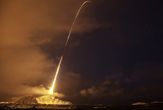
NASA Rocket Flies Through Earth's Shimmery Auroras

On an island inside the Arctic Circle last Sunday (Dec. 12), the frigid darkness of the early morning hours was broken by an intense orange glow, as a NASA rocket blasted off for a brief flight arcing through Earth's aurora, or northern lights.
These shimmering atmospheric phenomena, produced when charged particles from the solar wind are sucked in by Earth's magnetic field, seem to create drag on satellites, and scientists are trying to figure out why.
The 65-foot (19.8 meter)-long rocket launched from Norway's Andøya Rocket Range, packed with instruments to take data on neutral gas, electric and magnetic fields, precipitating particles, and other conditions inside the aurora.
During its 10-minute flight, the rocket sent reams of data back to Earth before hurtling into the Norwegian Sea about 900 miles (1,450 kilometers) south of its launch point.
The Rocket Experiment for Neutral Upwelling, or RENU, is aimed at measuring the complex, underlying physics behind satellite drag, which seems to be particularly noticeable during periods of more fantastical auroral displays.
Marc Lessard, associate professor at the University of New Hampshire and lead RENU investigator, said the study is taking a new scientific approach in its attempt to test, measure and quantify "electron precipitation" — the phenomenon that produces the other-worldly light shows of the planet's auroras.
"This is the first time anyone has tried to measure these neutral particle enhancements at these altitudes and with this combination of instruments," Lessard said.
Sign up for the Live Science daily newsletter now
Get the world’s most fascinating discoveries delivered straight to your inbox.
Although the effect of satellite drag can negatively impact a spacecraft's orbit over time — a concern for certain low-orbit, strategic satellites — Lessard stressed this was not the primary motivation for the experiment.
"From NASA's point of view this is a mission of pure science," Lessard said. "We're trying to understand the processes behind neutral upwelling and how it is associated with visible aurora phenomena."
Although Sunday's launch was an eventful one — with several holds at T-10 minutes and T-2 minutes — Lessard says the experiment appears to have been a success. But because so much data was gathered, it could take months to analyze the results.
This article was provided by SPACE.com, a sister site of LiveScience.com.
